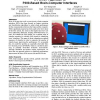42 search results - page 8 / 9 » User intentions funneled through a human-robot interface |
IUI
2010
ACM
14 years 4 months ago
2010
ACM
Most of the previous work on non-invasive brain-computer interfaces (BCIs) has been focused on feature extraction and classification algorithms to achieve high performance for the...
SIGCSE
2005
ACM
14 years 27 days ago
2005
ACM
In this paper we describe how a single Khepera II robot was used for an assignment in a senior level course on graphical user interface implementation. The assignment required eac...
MM
2006
ACM
14 years 1 months ago
2006
ACM
We used human movement as the basis for designing a collaborative aesthetic design environment. Our intention was to promote social interaction and creative expression. We employe...
CVPR
1999
IEEE
14 years 9 months ago
1999
IEEE
The development of user interfaces based on vision and speech requires the solution of a challenging statistical inference problem: The intentions and actions of multiple individu...
ICMI
2005
Springer
14 years 26 days ago
2005
Springer
This paper describes the Hapticat , a device we developed to study affect through touch. Though intentionally not highly zoomorphic, the device borrows behaviors from pets and th...

